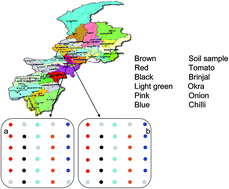Contamination of soil with heavy metals from industrial effluent and their translocation in green vegetables of Peshawar, Pakistan
Abstract
Heavy metal pollution is a serious problem in countries like Pakistan, claiming soil, water and food resources rapidly due to negligence. Accumulation and bio-concentration of seven heavy metals in vegetables growing in a mixed industrial effluent irrigated agricultural field near Hayatabad, Peshawar, Pakistan were determined by atomic absorption spectrometry. Ranges of concentration of copper, cobalt, iron, lead, chromium, manganese, zinc and nickel were 0.044–0.504, 0.009–0.085, 0.243–7.737, 0.496–0.474, 0.005–0.033, 0.019–2.019, 0.045–0.703 and 0.017–0.108 ppm respectively, in the edible parts of different vegetables growing in the area. Iron (Fe) accumulated to the highest level in all vegetables (P < 0.05). In general root was heavily contaminated with the metals, showing significantly greater accumulation than in other parts (P < 0.05). A significant amount of the metals absorbed by the vegetables was translocated to the edible parts, indicating health concerns. Cultivation of vegetable crops with such industrial effluent is not recommended on the studied land without certain remediation.


 Please wait while we load your content...
Please wait while we load your content...